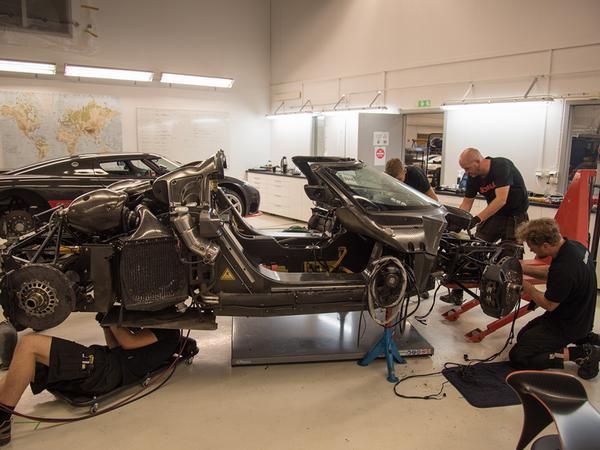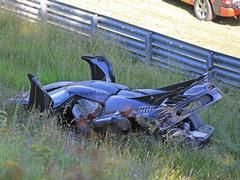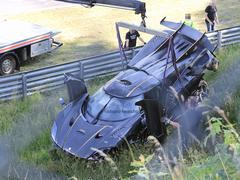Koenigsegg 'ring crash - why it happened
Credit to Koenigsegg for sharing the reasons for the One:1's dramatic testing crash at the Nordschleife

Fair play to Koenigsegg then. After the One:1 crashed so spectacularly at the 'ring during testing on Monday it's put up a detailed public statement explaining what happened. And, no, it wasn't a mystery patch of diesel...
As our spy snappers noted, from the two black lines leading to the scene of the accident the One:1 appeared to have suffered some manner of lock-up before jumping the barrier at Adenauer Forst and rotating through 180 degrees as it flew for over 20 metres. Koenigsegg notes that all safety systems, from airbags to safety cell and automatic fuel shut-off, operated as they should and a small fire at the back of the car from where the bodywork came into contact with hot exhausts was extinguished by the driver.
From examining the car and attempting to replicate the circumstances Koenigsegg has attributed the crash to the failure of the left front ABS sensor, causing the lock-up and loss of control. It points out a warning light would have appeared on the dash when this occurred but accepts a driver flat out through Fuchsrore in a One:1 might be forgiven for missing that. And in normal circumstances the car would remain driveable, unless you were driving to a level where you were leaning against ABS intervention to slow the car down. As a test driver going for a time might.
In response to this incident Koenigsegg will now include ABS in its Active Systems Warning management, which puts the car into a 60mph limp mode if active features like the adjustable aero, ride height or damping fail. Lesson learned, though they probably wish it had been in slightly less spectacular circumstances.
The full statement is commendably frank and makes interesting reading, with credit to Jalopnik for bringing it to our attention. Will the One:1 return to the 'ring? Koenigsegg says it is "hard to say at this moment, but we won't say a definite 'no'" while offering thanks for the "heartwarming" level of public support that followed the crash.
See below for the statement in full.
Statement issued by Koenigsegg following Nurburgring testing crash, reproduced verbatim as published on the company website 21/7/16
A Koenigsegg One:1 endured a severe crash at the Nürburgring Circuit in Germany last Monday, 18th July. The accident occurred at approximately 16:30 hours, some 3.5 hours into a session of Industry Pool testing that began at 13:00 hours.
The vehicle has since returned to Ängelholm and upon examination of both the car and the on-board telemetry, we have been able to deduce the following:
The One:1 experienced front axle brake lock-up at approximately 170 km/h on a section of the track known as Fuchsröhre before hitting the fence at Adenauer Forst at approximately 110 km/h. The impact with the fence launched the car into the air for an estimated 22 meters while it turned 180 degrees before it landed on its left rear wheel and pivoted to land parallel with the fence. The airbags, fuel shut-off and other safety systems all deployed as they were designed to do.
There was a small fire in the rear section of the car due to contact between the carbonfibre rear panels and the exhaust upon landing. This fire was extinguished by the driver using a fire extinguisher that was located inside the car.
The accident has been traced to a fault with the front left ABS wheel sensor signal.
Data analysis shows that the dashboard ABS warning light was triggered as soon as the ABS wheel sensor malfunction occurred. The small yellow ABS warning light is located centrally in the dashboard but may be difficult for the driver to see when he is wearing a helmet and concentrating on high-speed driving around the circuit. The driver may not necessarily notice any difference in the braking feel as long as he is not near the ABS braking zone, i.e. braking hard enough that it would have triggered the ABS system.
Whilst the ABS warning was activated well in advance of lock-up, data analysis shows that the driver's brake application at Fuchsröhre was the first brake application in the ABS zone. Hence, it was the first opportunity for the driver to notice the ABS fault through the brake pedal.
Our ABS system, like most, includes a back-up feature where the rear wheels are allowed to continue rotating in the event of an ABS fault that results in the front wheels locking up. Letting the rear wheels rotate instead of locking up together with the front wheels prevents the car from rotating. Instead, the car will continue in a straight line. The system worked to specification, as can be seen by the straight skid marks left by the front tires on the track prior to the car colliding with the fence.
Our engineers spent several hours on Wednesday, July 20th, replicating the fault using a similar car at our factory test track. The left front wheel ABS sensor was disconnected and ABS-level braking force was applied. We found results that were entirely consistent with those experienced by the One:1 at the Nürburgring.
If an ABS fault is triggered in the normal course of driving, the customer would normally take heed of the warning light, stop the car and have the fault attended to. As long as heavy ABS braking is not needed the car will stay fully drivable and most people would drive it to the nearest service facility to have them examine the system. It was our severe misfortune that this fault occurred just prior to the first instance of ABS-braking into a corner during high-speed testing on the world's most demanding test track.
While the One:1 sustained severe damage to its exterior panels and sub-frames (front and rear), the carbon monocoque chassis and airbag restraint system performed according to design specifications and protected the driver well. Examination of the vehicle at our factory in Ängelholm shows that there were no fuel leaks, no oil leaks and no hydraulic fluid leaks whatsoever, which is positively reassuring, given the force of the impact.
The carbon monocoque chassis has been examined at our factory in Ängelholm (photographed today, above). The monocoque is intact and will form the basis for the rebuild of the car in the near future, together with the engine, gearbox and many other systems. Both doors were fully operational, opening and closing in their original positions. The removable roof is fully intact and properly aligned.
Given this unfortunate and unlikely situation and given that we have the tools to further enhance our cars' safety in this regard, we will implement software changes that will be rolled out to all applicable vehicles in the near future.
Modern Koenigseggs already have an Active Systems Warning regime in place. This is a system that is well above all legal requirements. The Active System Warning monitors all active systems in the car - the front aero flaps underneath the bumper, active ride height system, active rear wing and our active rebound dampening. If a fault is triggered in any of these active systems, a flashing light appears on the dashboard along with an ACTIVE SYSTEMS WARNING light. The car is then restricted to 100 km/h until the fault is fixed and cleared in the system. We will act immediately to include the ABS system in this Active Warning System regime. This will have the dual effect of heightening driver awareness of the fault and restricting vehicle output until the fault is fixed.
This incident will not stop us from continuing our intensive testing at the Nürburgring, but it will halt it for some time as the team behind the effort will focus on rebuilding this car before going back again. Today it is a bit hard to say exactly how long that will take but we will do it as efficiently as possible. Will we be back this year? That is also hard to say at this point, but we won't say a definite 'no'.
Koenigsegg Automotive AB is committed to building the world's best performance cars. The world of high performance is inherently dangerous but a critical part of our commitment is making the cars as safe to drive as such cars can be. As is customary with severe Nürburgring accidents, our professional driver was taken to hospital for routine tests. Encouragingly, he was released later the same afternoon. We thank him for his alertness in putting out the fire directly after the impact.
We are also extremely grateful for the level of public support we have received since this incident. It is truly heartwarming.
Stay Tuned!
[Sources: Jalopnik, Koenigsegg]
[Spyshots: S. Baldauf/SB-Medien]
Gassing Station | General Gassing | Top of Page | What's New | My Stuff





